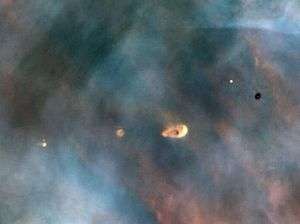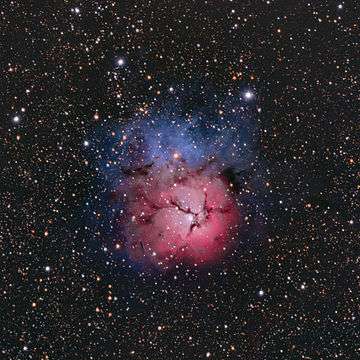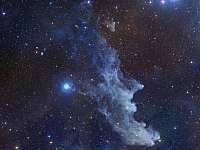Nebulae in fiction
Nebulae, often being visually interesting astronomical objects, are frequently used as settings or backdrops for works of science fiction.
General uses of nebulae
- The Young Black Stallion (1989), children's book in the Black Stallion series written by Walter Farley and Steven Farley. Young Alec Ramsay imagines a legendary origin for his magnificent black: In it, the horse is none other than that celestial equine silhouetted in the Horsehead Nebula against a curtain of glowing gas and illuminated by millions of stars—an image briefly glimpsed by him at the Hayden Planetarium years before.[1]
- "Our Tribe" (1991), episode of the television series Northern Exposure, written by David Assael and directed by Lee Shallat-Chemel. In this episode reluctant physician Joel Fleischman undergoes a cultural conversion after receiving a goat as a gift from a grateful village elder, who insists on "adopting" him into her tribe, and the mysterious Holling Vincoeur shuts down the Brick restaurant, ostensibly to wax the floors. Vincoeur, an amateur astronomer, tells bush pilot Maggie O'Connell about a star he is searching out in the Horsehead Nebula which he has "purchased" in honor of an old friend.
- The 13½ Lives of Captain Bluebear (1999) fantasy novel by German writer and cartoonist Walter Moers. The plot is set in the fictional continent of Zamonia and its capital Atlantis, before they sink beneath the waves, and concerns the fantastical antediluvian adventures of the character Bluebear.[note 1] As he grows up and gains philosophical maturity he realizes that "everything is connected, from the cellular structure of a dandelion seed to an exploding star in the Horsehead Nebula" and that when you are in multidimensional space, you are everywhere at once—not only on Earth, "you're also on the moon and on Saturn, in the Horsehead Nebula and on Cassiopeia's starry throne." Moers uses the nebula in these fancifully diverse compendia to illustrate the broad spectrum of nature's possibilities.[2]
- "Rocket Man" (2007), episode #19, season 6 of Law & Order: Criminal Intent written by Siobhan Byrne O'Connor and directed by Michael Smith. Goren and Eames investigate the murder of an astronaut in this "ripped from the headlines" take on the infamous escapades of NASA astronaut Lisa Nowak—who made a marathon automobile trip across the country (wearing astronaut diapers and never stopping except to refuel) to kidnap a romantic rival. In the show, the space agency is NSA; its headquarters are in New York City, and when the detectives visit they encounter a large interior translight depicting the Horsehead Nebula.
- Angels & Demons (2009), film written by David Koepp and Akiva Goldsman based on the novel by Dan Brown, and directed by Ron Howard. A devious plot against the Catholic church involves the ritual tetra-elemental themed slayings of four holy cardinals and the threatened destruction of the Vatican itself by means of the catastrophic annihilation of a phial of antimatter stolen from CERN. The antimatter has been produced by Father Silvano Bentivoglio (subsequently murdered) and the beautiful Dr. Vittoria Vetra (romantically available) at the Large Hadron Collider. When the film's protagonist, Professor Robert Langdon, investigates, he is confronted in Bentivoglio's office by a large poster displaying an image of the Hourglass Nebula.
There follow references to imaginary and real nebulae depicted as locations in space or the locations of planetary systems, categorized by genre.
Imaginary nebulae in fiction
Authors of science fiction have occasionally created imaginary nebulae in response to special plotting needs.
- "Legends of Smith's Burst" (1959), short story written by Brian Aldiss and published in Nebula Science Fiction.[3] Jami Lancelo Lowther, the peripatetic interstellar loan shark, is taking it on the lam. He books passage to New Droxy on an illegal matter transmitter, whose substandard beam deposits him instead on the planet Glumpalt deep in the disturbed space of Smith's Burst, a notable intragalactic nebula. Here he suffers many indignities and tricks many adversaries, and witnesses as well the rising of the black sun, an antimatter star that appears as "a great sooty ball, crammed with darkness, radiating blackness."—a strange anomaly owing its existence to the creation of the Burst from the "collision of two clouds of cosmic gas, one of them composed of antimatter," a confluence which led in due time to the formation of the remarkable Glumpalt, as well as its liberal deposits of antimatter-sustained antigravity stones.[4]
- Berserker Blue Death (1985), novel in the Berserker series by Fred Saberhagen. In this 25th-century retelling of Herman Melville's classic tale, obsessive Miles Domingo of Shubra plays Ahab to the Moby Dick of Leviathan (aka Old Blue), an automated alien warship programmed to destroy life. Domingo and his irregular human force ratchet up a game of cat and mouse with the Berserker craft through the murky corridors of the dense Milkpail Nebula: Even the brightest suns could no longer be located with any certainty amid the thickening, muffling clouds of white, off-white, and gray, the ever-changing pastel shades of perpetual interstellar dawns and sunsets ... suspended against an endless background of distant white billows and luminous pastel columns, the enemy machine was a construction of dark gray planes and angles ... During this running battle Domingo discovers, establishes mental rapport with, and recruits the aid of the Nebulons, mysterious energy-based lifeforms inhabiting the unexplored reaches of the Milkpail (compare the telepathic nebular being in "A Kind of Artistry" by Brian Aldiss, below).[5] In Saberhagen's deft modernization of the hoary but useful alien monster theme, the unrelenting Berserkers seem almost tangibly chill with the unlivingness of the Universe.[6]
Real nebulae in fiction
The following sections exhibit a collection of real nebulae that contain imaginary stars or planetary systems, or that otherwise serve as settings for works of science fiction:
Andromeda Nebula/Great Nebula in Andromeda
.jpg)
Spiral nebula cataloged as M31. Although this object is now known to be a galaxy, some authors aim for an archaic flavor by referring to it using its historical designation as a nebula (see graphic). For works of fiction which feature Andromeda as a galaxy, see Galaxies in fiction.
- Andromeda Nebula (1957), a novel by Ivan Yefremov which is a major milestone in Soviet SF literature.[7]
- The Vance Integral Edition (2005), collected works of Jack Vance.[8] Science fiction writer Jack Vance repeatedly refers to Andromeda in his works, always as a nebula, and never as a galaxy:[9]
- The great nebula in Andromeda passed under them, a whirling pancake of cold fire. ("Dead Ahead" as "Ultimate Quest," 1950)
- I am conducting a statistical count of the Cepheid variables in the Great Nebula of Andromeda. ("The Absent Minded Professor" as "First Star I See Tonight," 1954)
- No problem there; I'll take you to the Great Nebula if you like. (Space Opera, 1965)
- ...thence by [the] Andromeda Line ... in the direction of the Great Nebula ... ("Milton Hack from Zodiac" as "The Man from Zodiac," 1967)
- ...a spiral nebula, the Great Nebula in Andromeda, spinning, reeling, flashing, glimmering, alone and tremendous in the darkness of space. (The View from Chickweed's Window, 1979)
- ...send them off to the Great Spiral Nebula. (Araminta Station, 1987)
- I mentioned Emperor Schulz, who owned the Great Nebula in Andromeda. (Throy, 1992)
- Mass Effect: Andromeda (2017), a video game developed by BioWare Montreal and published by Electronic Arts. The game is a spin off of the original Mass Effect trilogy, set 600 years following the events of Mass Effect 2. In the game, each race participating in the initiative sends a large ship, called an Ark, on a 600-year voyage to Andromeda. Each ship contains the races' best and brightest volunteers, suspended in cryosleep. The player takes control of one of the customizable Ryder twins and becomes the "Pathfinder", responsible for making decisions in how the humans will settle the new galaxy, and how humanity will help find the other races' missing arks.
Crab Nebula

Supernova remnant cataloged as M1. The Crab Nebula is the residue of supernova SN 1054, which also left a neutron star, the Crab Pulsar, at its center (see graphic). The nebula's spattered, explosive appearance has stimulated several authors to imagine the purposeful destruction of its progenitor star by one or another race of aliens.
- "First Contact" (1945), novelette by Murray Leinster published in Astounding Science Fiction. In this puzzle story, a human exploration vessel encounters a like alien craft in the vicinity of the Crab Nebula. Neither ship knows the location or even the direction of the other's home planet, but they can be sure it is far away from the recently (in cosmic terms) sterilized neighborhood of the Crab.
- "Colony in Space" (1971), serial written by Malcolm Hulke for the television series Doctor Who. The Doctor and his companion Jo are dispatched by a committee of Time Lords to the planet Uxarieus (see graphic) to investigate indirect evidence of an attempt to resurrect an ancient doomsday device. On Uxarieus, the Doctor encounters a three-way battle between farmers, miners, and autochthonous "primitives"—and also his nemesis the Master, who reveals to the Doctor that the primitives were once an advanced civilization. Before their collapse, they built a super weapon capable of projecting antimatter at superluminal speed—a weapon the Master now covets for himself. The device was so powerful that in a test firing at a nearby star, it triggered the supernova that created the Crab Nebula.
- Colossus and the Crab (1977), third novel in the Colossus trilogy by Dennis Feltham Jones.[note 2] Martians—possessed of vast intellect, powers of transformation and telepathy—appear unexpectedly on the Earth. Having immobilized the Colossus computer system that handles humanity's affairs, they make a startling demand: half the world's oxygen, to be transported to their own small globe. Only oxygen can shield Mars (as well as the Earth) against a deadly storm of "Gammarad Six" radiation due to arrive from the novel's eponymous Crab Nebula. Furious maneuvering and increasingly violent skirmishing follow this demand until finally the original Colossus mainframe brokers a peace between the sides, with the sweetener thrown in that humanity will be able to retreat to Mars once the Sun becomes a red giant and destroys the Earth—true long term planning that only Colossus would have conceived of.[10]
- Battle of the Planets (1978-1985), American version of the Japanese television program Gatchaman, directed by David Hanson and Alan Dinehart. The five youthful protagonists of G-Force protect Earth from the evil planet Spectra and its villainous, masked commander Zoltar, and from assorted collateral attacks out of the depths of space. Spectra is the name of both the planet, located near the center of the Crab Nebula, and of the ruthless organization it heads, a nemesis to the Federation of Peaceful Planets (which includes the Earth, Arcturus and Vega). The minions of this ancient world, which is slowly dying in the sterilized wastes of the nebula, will stop at nothing to pillage the Earth of its rich natural resources and enslave its inhabitants.[11]
- Psion (1982), Telepathic Cat series novel written by Joan D. Vinge. Talhassium, element 170, occurs as a blue-silver crystal that is an essential component of massively miniaturized computer systems—so potent that a fist-sized chunk can host a planetary information web. It is also: an element so rare that it is almost impossible to find outside the heart of a star ... [but mankind] needs it by the kiloton to make its new faster-than-light stardrive cheap and simple. Galactic civilization can only flower once the planet Cinder, an almost solid mass of talhassium ore forged in the crucible of supernova SN 1054, is discovered in orbit around the Crab Pulsar.[12] Psion, first published as a juvenile, is a mythic story patterned into a world that is only superficially sciencefictional, strongly in the tradition established by Andre Norton.[13] Talhassium bears a significant resemblance to the element Illyrion that is a central conceit of Samuel R. Delany's 1968 novel Nova.[note 3]
- FreeSpace 2 (1999), combat simulation computer game designed by Dave Baranec et al., and published by Volition When the brutal Shivans invade, the Terrans join with their erstwhile rivals the Vasudans to form the Galactic Terran Vasudan Alliance (GTVA). At the beginning of the Second Shivan Incursion (2367), the enemy juggernaut Sathanas blasts the star Capella—home of the GTVA 3rd Fleet and of the player-starfighter pilot—into a supernova. In their ages-gone-by destruction of the once vast empire of the Ancients, the Shivans had done the same for that civilization's home sun, a cosmic catastrophe that produced the Nebula, the named site of frequent skirmishes between Shivan and Alliance juggernauts, of which it is said, "We have entered a nebula, a vast and dense ionized field, and possibly the remnant of a supernova." The Nebula also contains the remote node of the first Knossos Device (a subspace portal designed by the Ancients) discovered by humanity, in the Gamma Draconis system in the same year 2367. The estimated in-game dating and magnitude of this stellar holocaust suggest that it was SN 1054, and that the Nebula is the Crab Nebula.
- Mass Effect (2007), video game developed by BioWare and published by Microsoft Game Studios. The player character is Commander Shepard, who, with their ship, the Normandy SR-1, fights to defend Earth and the galaxy from the periodic (once every 50,000 years) genocidal campaign lately re-launched by ancient machine-like beings known as Reapers and their cat's-paw, the rogue galactic super-agent Saren Arterius, together with his army of geth AIs (compare the ancient AI-controlled Berserkers in Berserker Blue Death, above). In the gameplay universe, the Hades Gamma cluster lies on a major galactic arterial for trading ships large and small, legal and illicit, overt and hidden; it is home to five important stars including Antaeus, Cacus, Dis, Farinata, and Plutus.[note 4] Illustrations of the cluster in the game itself superimpose these planets on an image of the Crab Nebula.
- In the 1987 Teenage Mutant Ninja Turtles cartoon episode Artless, the TMNT and Splinter trick extraterrestrials from the fictional planet of Lookra, who visit the Earth to steal famous renaissance artworks in Italy, by placing the text "Made in Crab Nebula" on the artworks.
Eagle Nebula
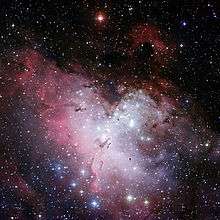
Diffuse emission nebula, or H II region, cataloged as M16. The Eagle Nebula, so named from its supposed resemblance to the iconic raptor (frontal view, wings spread, head bowed), is the location of one of the Hubble Space Telescope's most popular images, the Pillars of Creation (see graphic below), which often appear in science fiction film and television. The picture was released by NASA in 1995; within two years (1997) it had already found use in a number of works.
- The Derelict (1965-09-22), episode 2 of Lost in Space. The scenes where the astronauts are stuck outside the space ship, the background space is the Eagle Nebula, centred on the Pillars of Creation.
- Contact (1997), film written by James V. Hart and Michael Goldenberg, and directed by Robert Zemeckis based on the novel by Carl Sagan and Ann Druyan. This film, the story of SETI researcher Dr. Eleanor Arroway who finds strong evidence of extraterrestrial life and is chosen to make first contact, opens with a famous "zoom out" sequence starting from the Earth that passes a number of iconic astronomical objects and serves to embed our planet in a dazzling cosmic context. One of the featured regions of interstellar space is the stellar nursery pictured in the Pillars of Creation photograph of the Eagle Nebula.[16] Compare the use of the Horsehead Nebula in the film The Tree of Life directed by Terrence Malick, below.
- "Year of Hell" (1997), episode of Star Trek: Voyager written by Brannon Braga and Joe Menosky, and directed by Allan Kroeker and Mike Vejar, as part of the film, television, and print franchise originated by Gene Roddenberry. In the year 2374, the USS Voyager gets entangled in a time war with the Krenim, a race that has learned to broadcast temporal disruption waves; weakened by causality shifts, the Voyager takes refuge in a certain nebula: Images of the Pillars of Creation in the Eagle Nebula are displayed in the ship's astrometrics bay. Only by the desperate measure of ramming the Krenim timeship does the Federation vessel succeed in canceling the spurious timeline instrumental to the war's launch, so that it may return to "normal" reality where the Krenim are properly obsequious.
- "Into the Fire" (1997), episode of Babylon 5 written by J. Michael Straczynski and directed by Kevin Dobson. The Vorlons and the Shadows, both elder races of the galaxy, have been charged with nurturing the younger starfaring species, including humanity. Instead, they have used these species as pawns in a never-ending series of conflicts: the Shadow Wars. John Sheridan, the commander of Babylon 5 Station, manages to assemble an alliance of disparate civilizations that engineers a final showdown between the two antagonists at Coriana VI, ending the final Shadow War. The climax of this CGI-heavy episode is acted out in deep space, against the backdrop of the Eagle Nebula: Before the Pillars of Creation hovers the rotating ring of a base station, while its warships emerge from the blue whirlpool of a hyperspace jump point in the middle distance (see graphic).[17]
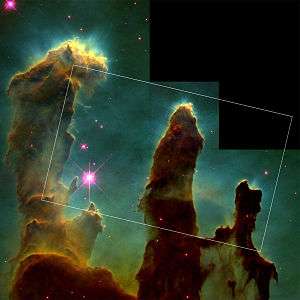
- Mass Effect 2 (2010), video game developed by BioWare and published by Electronic Arts (see Mass Effect above for a brief description of the game universe). In the mission "The Warlord" the player Commander Shepard tracks down Dr. Okeer, a brilliant and brutal Krogan warlord who has gone to ground on the spaceship graveyard planet (and interstellar homicide capital) Korlus in the Imir system. The assignment "Abandoned Research Station" plays out on Jarrahe Station around Strabo, and the assignment "Wrecked Merchant Freighter" is set on the planet Neith of the star Amun. All three stellar systems are located in the Eagle Nebula, as in-universe maps attest.
- Elite: Dangerous (2014), computer game written by David Braben et al. The Eagle Nebula, distant from populated regions of the galaxy, contains a prison colony built inside an asteroid.
Horsehead Nebula
Dark nebula cataloged as B33 in emission nebula IC 434, located close to the belt-star Alnitak in the constellation Orion (see graphic). The Horsehead Nebula is part of the much larger Orion Molecular Cloud Complex. Many of the works of fiction below use the nebula as a cloud of more or less impenetrable darkness; others imagine a host of stars and planets before, within, and especially behind the nebula.[note 5]
- The Stars, Like Dust (1951), Galactic Empire novel by Isaac Asimov. Beyond the Horsehead Nebula, the planets Nephelos, Rhodia, and Lingane are ripe for revolt against the hegemony of Tyrann, and their leaders search for a rumored free rebel planet somewhere within the nebula itself.[note 6] The action of the novel takes place in and around the dark nebular cloud, where the first space ships circled the Horsehead Nebula to find [a] nest of hundreds of oxygen-water planets behind.[18] Asimov conducts a clinic on geocentrism in a galactic setting, having a character state that the literal adjective "horsehead" is meaningless from non-terrestrial vantages, and that the "generally believed" alternate derivation (that the nebula was first breached by the eponymous explorer Horace Hedd) is far more plausible.[19][note 7]
- The Ship Who Sang (1969), fixup assembled by Anne McCaffrey. The parents of infants with severe physical disabilities but exceptional brains may elect to see them transformed into "shell people" rather than be subjected to euthanasia. After surgery placing the brain in a computer-controlled life support system, followed by general education and special training, shell children come of age and may become the controllers of specialized space ships: brainships. Helva is a shell person and a ship who leads a strange life in the space lanes of the Federated Sentient Planets—"the emotional difficulties facing a musical lady spaceship are many"[21]—accompanied by her companion and ship's brawn, Jennan. The Horsehead Nebula recurs in the story as a sort of tongue-in-cheek heroic destination: "To the Horsehead Nebula?" asked Nordsen, quoting and old Central saw. "To the Horsehead Nebula and back, we shall make beautiful music," said Helva, chuckling.[22]
- Space Pirate Captain Harlock (1977-1979), manga series written and illustrated by Leiji Matsumoto. In the future, Mankind has achieved a vast starfaring civilization, and yet is slowly but surely succumbing to ennui and despair, due to repeated defeat and steady subjugation at the hands of alien invaders. "Pirate" captain cum freedom fighter Harlock fights back with daring raids against Earth's oppressors, including the Mazone, a race of intelligent—and somewhat sympathetic—humanoid plant beings from beyond the Andromeda galaxy. The Mazone warrior Akias sets a trap for Harlock in the Horsehead Nebula complete with an electromagnetic whirlpool, a powerful gravity well, and a gigantic guided fireball. In spite of all this opposing firepower, Harlock triumphs, and Akias meets her fate at the bottom of a sea of magma.[23]
- The Hitchhiker's Guide to the Galaxy (1979), novel by Douglas Adams. Galactic President Zaphod Beeblebrox and his companion Trillian have stolen the Infinite Improbability Drive prototype ship Heart of Gold and, aiming for the Horsehead Nebula, they instead get zapped to Sector ZZ9 Plural Z Alpha, passing through every point in the Universe on the way. Eventually reaching the Nebula, and recognizing their location by the sheer impenetrable darkness outside, they discover the ancient planet Magrathea and its twin suns Soulianis and Rahm. Magrathea is a world whose economy was based on the manufacturing of bespoke planets for the wealthiest people in the universe, back in the days of the Galactic Empire (it was Magrathea that created the Earth).[24]
- Widget (1990-1991), animated television series created by Peter Keefe. This ecologically themed show features the exploits of a diminutive purple alien named "Widget" from the Horsehead Nebula who has the power of shape-shifting. He and a group of young human friends meet with a series of adventures as they protect the natural environment from those who would plunder or harm it. Each episode has Widget contending with a villain from either Earth or outer space wishing to exploit our planet's natural resources.
- Ancient Shores (1996), novel written by Jack McDevitt. A vitreous domed structure discovered on a Sioux reservation in North Dakota yields startling secrets: Its fiberglass-like substance is composed of the "impossible" superheavy element 161,[note 8] and more astonishing yet, it functions as a jumpgate connecting the northern prairie to strange distant parts, including an idyllic landscape called Eden. A struggle for control of the artifact between the tribe and the United States government ensues. Meanwhile, in Eden, on a fairy-tale beach one evening, young airplane pilot Max encounters a strange girl: "Look." She pointed out over the sea. A thunderhead floated over the horizon, flecked with liquid lightning and countless blue-and-white lights. "I've seen that before," she said. / So had Max. It looked like an oncoming storm, but it had the distinct shape of a chess piece. A knight. / "I think it's the Horsehead Nebula," he said.[25]
- "Old Soldier" (1999), episode of the French/English television series Malo Korrigan and the Space Tracers, created by Arthur Qwak and Norman J. LeBlanc. Malo Korrigan is a Tracer: a freelance jobber, transporter, and sometime smuggler in a universe that has little room—or tolerance—for his ilk. In the episode "Old Soldier", Korrigan's ship the Starduke breaks down in the midst of the Horsehead Nebula. With the Starduke adrift in space, Malo and his engineer Jonas have an idea: they will land on a nearby "junkyard" planet strewn the carcasses of old spacecraft. But, while they comb the hulks for spare parts, something attacks.
- "The Impossible Planet" and "The Satan Pit" (2006), episodes of the television series Doctor Who written by Matt Jones and directed by James Strong; "Planet of the Ood" (2008), episode written by Keith Temple and directed by Graeme Harper. In the first two episodes the Doctor is visiting a strange world orbiting a black hole, whose normally passive slave race, the Ood, have been psychically possessed by an evil entity imprisoned in the center of the planet: the Beast. In the end both Beast and maddened Ood fall into the singularity and perish. In the later episode, the Doctor visits the Ood homeworld, the Ood-Sphere (see graphic), and liberates the fundamentally decent race from a permanent state of servitude to the trafficking Ood Operations corporation. The Ood-Sphere is a barren, icy planet with vast mountains and caves, and with two moons and a greyish-pink Saturnlike planet in its heavens. The world lies in Mutter's Spiral in the midst of the Horsehead Nebula, close to the Sense-Sphere. This planet is the home of the telepathic Sensorites, visited by the First Doctor in The Sensorites.[26]
- Mass Effect (2007) and Mass Effect 3 (2012), releases of the video game developed by BioWare and published by Electronic Arts (see Mass Effect above for a brief description of the game universe). The Horsehead Nebula (written as "Horse Head Neblua" in the game) is a navigable cluster, containing the following stars and their planets:
- Strenuus system: Yunthorl, Antitarra, Trelyn, Xawin, Thesalgon, and the ship MSV Majesty
- Pax system: Svarog, Noveria,* Morana, and Veles
- Fortuna system: Maganlis, Amaranthine, Therumlon, and Wentania
- Anadius system (red supergiant): Cronos Station†
- *Noveria, the secret ice world where the Noveria Development Corporation pursues advanced, controversial research, has attracted the attention of the geth artificial intelligences, and the council needs to know why—a job for protagonist Commander Shepard and the Normandy (Mass Effect).
- †The headquarters of the human supremacist organization Cerberus has been discovered on Cronos, and Shepard is sent in to bring out an AI who will play a key role in the final battle against the Reapers (Mass Effect 3).
- The Tree of Life (2011), film written and directed by Terrence Malick. The three boys of the O'Brien family grow up in suburban Waco, Texas, raised by their nurturing mother and their strict but loving father. Thirty minutes in, the film is interrupted by—or integrated with—a 22-minute segment mystically portraying the birth of the universe, the galaxies, the stars, planets, and finally the development of life on Earth itself. For the "astrophysical" portion of this sequence, Hubble photos were stitched together and high-res images were created and broken down into layers with depth and parallax and gentle camera moves. A prominent image in this montage shows the Horsehead Nebula.[27] Compare the use of the Eagle Nebula in the film Contact directed by Robert Zemeckis, above.
Hourglass Nebula
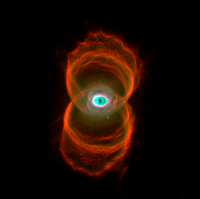
Planetary nebula cataloged as MyCn 18 discovered by Mayall and Cannon in the early 20th century, but only resolved as an hourglass shape by the Hubble Space Telescope in 1996 (see image).[28] It is conjectured that the hourglass shape is produced by the expansion of a fast stellar wind within a slowly expanding cloud which is denser near its equator than its poles. The formation of the shape of the inner "eye" is not yet fully understood. Because of the recent resolution of the nebula's detailed appearance, it has only appeared in fictional works since 1996.
- Final Doom (1996), first-person shooter video game and sequel to Doom and Doom II: Hell on Earth, developed and published by Id Software. In this installment of the Doom franchise, the Union Aerospace Corporation is once again experimenting with dimensional gateway technology at their secret base on the moon Io. The satellite is overwhelmed by an army of demons erupting out of a ship from Hell built of steel, stone, flesh, bone and corruption. The player-protagonist, fortuitously escaping the massacre, swears revenge on the legions of Hell. This is played out amply, be it under SKY1 (daytime, with a muddy sky and horizon of snowcapped mountains), SKY2 (starry night sprinkled with points of light and a dominating image of the Hourglass Nebula looming over all), or SKY3 (a rendering of the flaming sky of Hell, bright red and overcast). The Hourglass Nebula was used as a SKY in Final Doom very soon after its first detailed imaging by the Hubble.
- Space Pirate Captain Herlock: The Endless Odyssey (2002), original video animation sequel to the manga Space Pirate Captain Harlock, the video directed by Rintaro (Shigeyuki Hayashi). In the final episode of Endless Odyssey, Harlock is not surprised to find his closest friend, the long-dead Tochirō, waiting for him within the Hourglass Nebula, an apparent interdimensional nexus. In a poignant moment of nostalgia, Tochirō wishes that he and Harlock could drink together for just one night, and Harlock, knowing that the moment cannot be now, says sadly "One day that time will come."
- Mass Effect 2 (2010) and Mass Effect 3 (2012), releases of the video game developed by BioWare and published by Electronic Arts (see Mass Effect above for a brief description of the game universe). The Hourglass Nebula is a navigable cluster, containing the following stars and their planets:
- Faryar system: Quarem, Daratar, Tunfige, Nephros, Alingon, Wenrum, asteroid belt, and Antictra
- Osun system: Orunmila, Purgatory,* Erinle, Aganju, fuel depot, Olokun, and the mass relay for the cluster
- Ploitari system: Aigela, Zanethu, Synalus, and Thegan
- Sowilo system: Uruz, Kenaz, Hagalaz,† Ansuz, Thurisaz, and Isa
- *Purgatory is a maximum security prison starship in orbit around the star Osun owned and run by the Blue Suns security organization. It is where Commander Shepard can undertake a Mission to recruit Jack—master criminal, potential romantic interest, and possibly one of the most powerful human biotics alive, considered so dangerous that she is kept in cryogenic stasis aboard the isolated prison vessel. (Mass Effect 2 ).
- †Hagalaz is a second-tier garden world that receives little attention from the galactic community. It is however the secret lair of the Shadow Broker, the enigmatic anonymous trafficker in classified information, and the location of the final showdown between Shepard's friend Liara T'Soni and the secretive master spy. (Mass Effect 2: Lair of the Shadow Broker ).
Lagoon Nebula
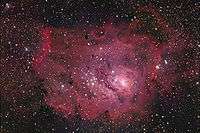
Diffuse emission nebula, or H II region, cataloged as M8. The Lagoon Nebula is one of only two star-forming nebulae faintly visible to the naked eye from mid-northern latitudes. Seen with binoculars, it appears as a distinct oval cloudlike patch with a definite core. A fragile star cluster appears superimposed on it. The Lagoon Nebula contains at its center a structure known as the Hourglass Nebula (so named by John Herschel), which should not be confused with the better known Hourglass Nebula (see above).
- Treasure Planet (2002), animated film written and directed by Ron Clements and John Musker, with additional screenplay credits to Rob Edwards. Teenage inkeeper and protagonist Jim Hawkins acquires a holographic map to the legendary Treasure Planet from a dying space pilot, and he recruits a motley crew to help prospect its riches. They begin their fantastic quest by embarking through a jump gate for the far reaches of space, with a first stop halfway across the galaxy at the Lagoon Nebula—a region populated by the extraordinary Zaftwings, or "gill-rats," who flourish in the tenuous near-vacuum of the nebular atmosphere.[29]
- "Home", Part 2 (2005), episode of the re-imagined Battlestar Galactica science fiction television series, written by David Eick and Ronald D. Moore, and directed by Jeff Woolnough. In this episode, Commander Adama and President Roslin lead the human forces to the Tomb of Athena on Kobol where, it is said, the pathway to the legendary planet Earth may be found. Lieutenant Kara "Starbuck" Thrace has brought the mystic homing compass, the Arrow of Apollo, and inserts it into a receptacle in a statue of the archer Sagittaron (see graphic) within the tomb. This causes a zodiac of constellations, as seen from Earth, to ignite in the darkness of the chamber, with the planet Caprica shining out from a roseate cloud recognized by Captain Lee "Apollo" Adama as the Lagoon Nebula. Commander Adama confirms this as Astral Body M8, and the pilgrims realize that the alignment thus limned of the Lagoon, Caprica, and the Earth shows them at long last a pathway to their destination.
- "Zero Hour (Expeditionary Force Book 5)" (2017), temporary staging area for the Flying Dutchman while they waited for Skippy the AI to return from fighting off the Worm. Colonel Joe Bishop had just sent the AI Nagatha Christie out to discover what had happened to Skippy while the crew tried to recover the jump coils.
Messier 78
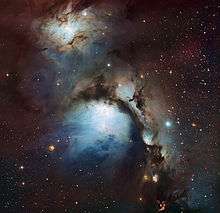
Reflection nebula in the constellation Orion, cataloged as M78 (see graphic). M78 is the brightest of a group of diffuse reflection nebulae that belong to the Orion Molecular Cloud Complex and is about 1,600 light years distant from the Earth. M78 is easily found in small telescopes as a hazy patch and involves two stars of 10th magnitude. These two stars, HD 38563A and HD 38563B, are responsible for making the cloud of dust in M78 visible by reflecting their light. About 45 variable stars of the T Tauri type,[note 9] young stars still in the process of formation, as well as some 17 Herbig–Haro objects are known in this nebula.
- Ultra Series (1966–), a long-running television and film tokusatsu series featuring the Ultramen (also known as the Ultras), created by Tsuburaya Productions. The Land of Light is a massive world located in Nebula M78. The Ultra homeworld, the Land of Light consists of a collection of levitating Emerald continents orbiting the planet's core. Originally, the planet had its own star, but when this star gradually died and became a black dwarf, the inhabitants built the Plasma Spark. This artificial star provided great strength to the then human-like people, transforming them into the first Ultras. The power given off by the star travelled so far when it was first switched on that it affected another planet in the neighbouring Nebula L-77 (the homeworld of Ultraman Leo and Astra), transforming the people who lived there into Ultras too. The Land of Light is a monarchy, ruled by a king and watched over by the Space Garrison, an organisation that seeks universal justice and peace—unless unduly provoked. Due to the strength and importance of the Plasma Spark, M78 has been the target for many aliens and enemies seeking to exploit or destroy it. The earliest conflict of this kind to affect M78 was the Great Ultra War, in which the evil alien Empera attempted to take over the planet after learning of the Plasma Spark's power. Dark Zagi, the main antagonist of Ultraman Nexus, tore a hole through the multiverse to reach the planet, but was repelled by the combined efforts of the Space Garrison and Nexus's true form, Noa. The Renegade Ultraman Belial also attempted to take the Plasma Spark twice. In his first attempt, he was successful, but was later defeated in the Monster Graveyard by Ultraman Zero and several members of the Ultra Brothers. In his second attempt, he attacked the Land of Light directly, but his army was dealt an embarrassing defeat. Many of the Ultras live on the Land of Light or other planets in the Nebula, including Leo and his brother, Astra, who reside in M78 after their home nebula, L-77 was destroyed by the Alien Magma.
- Nadia: The Secret of Blue Water (1990–1991), anime television series and film written by Hideaki Anno and Toshio Okada et al., and directed by Anno and Shinji Higuchi. The series follows a young inventor named Jean and a former circus performer named Nadia, who wishes to return to her home Tartessos, a forgotten city in central Africa. A gang of jewel thieves at first pursues Nadia for her otherworldly pendant gem Blue Water, but later ally with her and Jean together with Captain Nemo. In his submarine, the Nautilus, they struggle against the Neo-Atlantean forces led by Gargoyle, who seeks to dominate the world. It is finally revealed that Nadia herself and her jewel are descended from the Atlanteans, a race that came to the Earth from the M78 nebula thousands of years ago.
NGC 2440
Planetary nebula cataloged as NGC 2440. Its central star, HD62166, is possibly the hottest known white dwarf. The nebula, situated in the Puppis constellation, was discovered in 1790 by William Herschel, who described it as a "beautiful planetary nebula of a considerable degree of brightness, not very well defined." The nebula is located about 4,000 light years from the Sun, has a spectacular appearance and is located in a rich star field.
- "Crossroads", Part II (2007), episode of the re-imagined Battlestar Galactica science fiction television series, written by Michael Taylor and Mark Verheiden, and directed by Michael Rymer. Admiral Adama and the Colonial fleet skirmish with a Cylon task force in the Ionian Nebula; during the fight, Lee Adama picks up a mysterious intermittent contact and breaks off to intercept it. The bogey leads him on a vividly depicted chase through the nebula's dust clouds—and the pilot turns out to be the long presumed dead, maverick Viper pilot Kara Thrace. The Ionian Nebula, a supernova remnant rather than a planetary nebula in the Battlestar universe, resembles NGC 2440 and is a similar 4000 light-years from Earth. It is the fourth and last nebula of major importance seen in the series, as a marker on the way home to Earth (see "Home, Part II" set in the Lagoon Nebula, above).
Omega Nebula
Diffuse emission nebula, or H II region, in the constellation Sagittarius cataloged as M17, and named the Omega Nebula in 1833 by John Herschel because in his limited-resolution view its shape resembled the Greek letter Ω. Located between five and six thousand light-years from the Earth, It is considered one of the brightest and most massive star-forming regions of our galaxy, containing a collection of over 1000 stars[31]—although it is one of the youngest clusters known, with an age of just 1 million years. Its local geometry is similar to the Orion Nebula except that it is viewed edge-on from the Earth rather than face-on.[32]
- Mass Effect 2 (2010), release of the video game developed by BioWare and published by Electronic Arts (see Mass Effect above for a brief description of the game universe). The Omega Nebula contains the Omega space station, which serves as the central hub of the Terminus Systems, as well as the unmapped Omega 4 Relay. It contains the following stars and their planets:
- Amada System: Takkan, Karora, Eingana, Alchera, and Anjea
- Arinlarkan system: asteroid belt, MSV Strontium Mule, and Utha
- Batalla system: Logasiri, Thunawanuro, and Nearog
- Fathar system: Lorek, Korar, and Dorgal
- Kairavamori system: Sehtor, Vatar, and Uwan Oche
- Sahrabarik system: Urdak, asteroid belt, Omega,* Imorkan, fuel depot, Omega 4 Relay, Bindur, and the mass relay for the cluster
- *Built in the mined-out husk of a metallic asteroid, the Omega space station has been a haven for criminals, terrorists, and malcontents for thousands of years. The space station's original elegant design has given way to haphazard expansion by scrabbling factions of every species. It is the location of the missions Archangel, The Professor, The Veteran, Aria T'Loak, and The Ardat-Yakshi (all in Mass Effect 2 ).
Orion Nebula

Diffuse emission nebula, or H II region, cataloged as M42, and situated south of Orion's Belt in the constellation of Orion. It is one of the brightest nebulae, and is visible to the naked eye in the night sky. Located about 1300 light-years away, it is the closest region of massive star formation to the Earth. The Orion Nebula is one of the most scrutinized and photographed objects in the night sky, and is among the most intensely studied celestial features.
- The Orion Nebula is the location of the Xenomorph homeworld in the Alien vs Predator (1993) video game based on the Alien franchise. The game's soundtrack is called the Orion Nebula Music.
- Space Battleship Yamato III (1980-1981), the third television series of Space Battleship Yamato (translated into English as Star Blazers: The Bolar Wars (1984)), written by Noboru Ishiguro and directed by Leiji Matsumoto. A stray missile fired during an interstellar war causes the Sun's themonuclear reactions to surge out of control. Unless it can be stopped, the Sun will destroy Earth in one year and the entire solar system in three. Susumu Kodai (Derek Wildstar in the English language version), officially in command of the eponymous space battleship Yamato (Argo), is charged to help find a new home for Earth's population. This tale contrafactually places the Earth and the solar system in the Orion Nebula.
- The Naked God (1999), third novel in The Night's Dawn Trilogy, written by Peter F. Hamilton. The young Edenist Syrinx joins Adamist captain Joshua Calvert and his starship the Lady Macbeth on a mission to the Orion Nebula's far side to discover a mysterious deity: Where are we going? / To the Tyrathca Sleeping God, so we can ask it how to solve the possession crisis. Ione and the Consensus believe it's on the other side of the Orion Nebula... Later on in their voyage: The Orion Nebula veiled half the starscape to galactic north of Lady Mac, a glorious three-dimensional tapestry of luminescent gas with a furiously turbulent surface composed of scarlet, green, and turquoise clouds clashing as rival oceans (see graphic, right) ... Inside, it was knotted with proplyds (see graphic, right), the glowing protoplanetary disks condensing out of the maelstrom.[33] The God turns out to be a naked quantum singularity possessed of untold knowledge and power that it communicates to Captain Calvert, who ultimately saves humanity from a catastrophic plague of psychic possessions being inflicted on it by an army of ravening souls from the deep past.
- The Fountain (2006), film written and directed by Darren Aronofsky. The film tells a complex, era-spanning story involving actors in multiple roles across the ages, the tree of life, death, and immortality—a tale not dissimilar to the 2012 picture Cloud Atlas.[34] Recurring character Tom is an astronaut who travels to the golden nebula of Xibalba bearing the ailing Tree of Life, which is revitalized in a supernova that incinerates Tom but frees the spirit of his centuries-dead wife Izzi. The group of stars that appears in the movie is the Orion constellation, and the Xibalba Nebula is the Orion Nebula.[35]
- The Orion Nebula Adventure (2010), juvenile novel by William J. Hughes. The novel tells a four-part tale of Katie, Jennifer, and Ben's adventures from Mars to Pluto and beyond in their attempt to thwart the corrupt control of the Interstellar Alliance. Adventures indeed abound: Aboard [the vessel] Vixen Katie piloted her ship into the Orion Nebula toward the mystery it held ... "We have a dangerous situation here. We have discovered an alien civilization within the Orion Nebula. We were detected while on a recon mission and may be in danger of a possible attack...[36]
Trifid Nebula
Nebula of mixed types, catalogued as M20 and located in Sagittarius. Its name means "divided into three lobes." The body is an unusual combination of an open cluster of stars (a good setting for fiction), an emission nebula (the lower, red portion), a reflection nebula (the upper, blue portion) and a dark nebula (the apparent gaps or spokes within the emission nebula that cause its three-part appearance). Viewed through a small telescope, the Trifid Nebula is a bright and peculiar object, and is thus a perennial favorite of amateur astronomers.
- "The Alternative Factor" (1967), episode of Star Trek: The Original Series written by Don Ingalls and directed by Gerd Oswald as part of the film, television, and print franchise originated by Gene Roddenberry. Disturbed by a galaxy-wide energy pulse that causes a momentary break in the continuity of spacetime, Captain Kirk and the crew of the USS Enterprise discover two warring twins: the sane Lazarus A, from an antimatter universe parallel to our reality, and the insane Lazarus B, from our universe. If they ever meet face-to-face in either universe, everything will be annihilated in a cataclysmic explosion. The episode culminates in a battle between the antagonists in a negative magnetic corridor between the universes near the Trifid Nebula, a scene filmed in a smoke-filled room with orange and purple walls, then composited with a photograph of the nebula.
- Beast Wars (1996-1999), CG animated television series that debuted in 1996, serving as the flagship of the Transformers: Beast Wars franchise. The series is set in the future of the original Transformers universe as a sequel to the first Transformers series (1984-1988), with the Maximals as descendants of the Autobots and the Predacons as descendants of the Decepticons. Maximal and Predacon ships clash in deep space against a backdrop of the Trifid Nebula, crash-land on a mysterious planet, and continue their battle in the form of wild beasts.
- Space Mutiny (1988), science fiction movie chronicling a mutiny on a starship. In the movie, the mutineers ally themselves with the Alseca pirate fleet, and steer the ship into the "Alpha-Delta Restricted Zone", where a battle ensues against a backdrop of the Trifid Nebula.
Veil Nebula
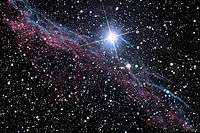
Supernova remnant, cataloged as NGC 6960 (and a variety of other designations). The Veil Nebula is one component of the large but relatively faint spherical residue of a supernova that exploded some 5 to 8 thousand years ago. Discovered in 1784 by William Herschel, the remnant appears to human observers as a braid of thread-like strands. The standard interpretation is that the shock waves defining its surface are so attenuated that the shell is visible only when viewed edge-on, giving it the appearance of a collection of filaments.
- A Kind of Artistry (1962), short story written by Brian Aldiss and published in The Magazine of Fantasy & Science Fiction.[37] Aristocratic fixer Derek Flamifew/Ende travels from his ancient, dying home, the planet Abrogun, on a first contact mission to the Veil Nebula[note 10] (see graphic) where the young planet Festi XV is home to an immense, gravity-based sentient being known as the Cliff. With a combination of high technology and high adventure, the shape-shifting human manages to contact the alien intelligence, which having nothing like an organized brain cannot communicate with Ende's mind, but only en masse with the multitude of cells that compose his body (compare the telepathic Nebulons in Berserker Blue Death by Fred Saberhagen, above).[39]
- Dark Star (1974), film written by John Carpenter and Dan O'Bannon, and directed by Carpenter. The scout ship Dark Star and its bored, eccentric crew wander the universe, armed with sentient "thermostellar" bombs. Their prophylactic mission: to destroy certain "unstable" planets that might threaten Earth's galactic colonization program. It's a tough job, but somebody has to do it. En route to the Veil Nebula,[40] the location of their next target world, the vessel's cybernetic systems become deranged. When they reach ground zero, a doomed planet 99% likely to spiral into its sun "in another twelve thousand rotations" and trigger a catastrophic supernova, the petulant bomb refuses to drop from the bomb bay—nor will it disarm itself. Urgent negotiations ensue. Finally the bomb, misinterpreting a philosophical point, detonates itself so that it and the ship are blown to smithereens. At least the planet is saved—for now.
- Stars Without Number (2010), Tabletop role playing game designed by Kevin Crawford, and published by Sine Nomine Pblishing. The Veil Nebula was the origin point of a catastrophic energy wave known as the Scream, which quickly killed every being with psionic abilities, or rendered them permanently insane. Because the Terran Mandate depended heavily on them to operate its infrastructure, a four hundred-year long dark age known as the Silence followed, where every colony was cut off and long-range interstellar travel became impossible.
Witch Head Nebula
Faint reflection nebula in the Eridanus constellation near Orion, possibly an ancient supernova remnant, cataloged as IC 2118. Because the gas cloud is illuminated by nearby blue-white supergiant star Rigel in Orion (see graphic; Rigel is off-image to the right), and due to its preferential scattering of short-wavelength light, it appears a vivid blue in telescopic images. Radio observations show the presence of molecular clouds and star formation; candidates for pre-main sequence stars and some classic T-Tauri stars[note 9] have been found deep within the nebula.[41]
- Andromeda (2000-2005), television series created by Gene Roddenberry and developed by Robert Hewitt Wolfe. The Nietzscheans, genetically engineered super-humans, are in revolt against the Systems Commonwealth. Commonwealth starship captain and series protagonist Dylan Hunt finds himself trapped, balanced in time stasis at the event horizon of a black hole, at a crucial juncture: just when the ultimate battle of the revolution is being joined by the Nietzscheans and the Commonwealth High Guard at the Witch Head Nebula. (There, the Nietzscheans say, the Angel of Death—the face of IC 2118 itself—appeared in the sky, and lit up the cosmos with fire.) The war ends in an exhausted stalemate, with the space fleets of both the Old Commonwealth and the Nietzscheans substantially destroyed; in the three galaxies an era of disorder and instability follows. In a later era, at long last Hunt is rescued from the edge of the hole, and it falls to him to restore the Systems Commonwealth and "rekindle the light of civilization."
See also
For a list containing many stars and planetary systems together with their role in fiction, see Stars and planetary systems in fiction.
Notes and references
Notes
- ↑ In a somewhat complicated joke, the title of the book is derived as follows: Bears (36 years) live about three times as long as cats (12 years). Cats have nine lives. Therefore bears have 27 lives. The novel covers the first half of Bluebear's life. Half of 27 is 13 1⁄2.
- ↑ Colossus (1966), the first novel in the Colossus trilogy, was filmed as Colossus: The Forbin Project in 1970.
- ↑ In the novel Nova, Earth and the Pleiades Federation vie for influence in the Outer Colonies where mines produce trace amounts of the prized power source Illyrion, the superheavy material (comprising elements 305 and above) essential to starship travel and terraforming planets. Lorq Von Ray, a scarred and obsessed captain from the Pleiades, recruits a disparate crew of misfits to help him achieve political and economic dominance by securing a vastly greater amount of Illyrion—seven ton's worth—directly from the heart of a stellar nova.[14]
- ↑ In Dante's Inferno, Antaeus, a murderous half-giant who drew his strength from contact with the earth, appears in Canto XXXI (later illustrated by Gustave Doré); Cacus, a pre-Roman anthropophage slain by Hercules, appears in Canto XXV; Dis, the location of the lower circles of Hell, appears in Cantos VII, XI, and XII; Farinata, a Florentine Ghibelline factional leader, appears in Cantos VI and X; and Plutus, the Greek god of wealth, appears across Cantos VI and VII (later illustrated by Gustave Doré).[15]
- ↑ A visual inspection of photographs of the Horsehead Nebula shows that, in a view from Earth, there are few stars in front of the nebula. Authors are free to imagine a trove of stars behind it.
- ↑ Asimov makes it clear that, from within, the dark Horsehead Nebula is a vanishingly thin mist, barely detectable save by its blockage of distant starlight. Compare this with Berserker Blue Death by Fred Saberhagen, above, where the pale billows of the Milkpail Nebula assume a sculpturally solid speleomorphic consistency.
- ↑ In his fable of the Horace Hedd folk etymology illuminating the limitations of geocentrism, Asimov outsmarted himself. From his earlier Galactic Empire novel Pebble in the Sky it is clear that the English language is no longer spoken either on Earth or in the larger galaxy: ... the woman [a resident of Earth's far future] spoke in no language Schwartz [a 20th-century Chicago man thrown forward through time] had ever heard.[20] The Horsehead/Horace Hedd pun only works in an anglophone galaxy. In his critique of geocentrism, the author neglected his own unconscious anglocentrism.
- ↑ Compare the superheavy element 161 in Ancient Shores to talhassium (element 170) in the novel Psion by Joan D. Vinge and Illyrion (an amalgam of trans-300 elements) in Nova by Samuel R. Delany.
- 1 2 T Tauri stars are immature pre-main sequence stars, powered by gravitational contraction rather than nuclear fusion. Many of them are surrounded by protoplanetary discs which will only later evolve into planets.[30] As such they are not good candidates for the hosts of habitable worlds in fiction.
- ↑ In his galactic cosmography, Aldiss locates the Earth in a region of the Milky Way called The Rift,[38] while he places the Veil Nebula—which lies in actuality less than 1500 light-years from the Sun—in the "remote" Sector Vermilion of the galaxy.
References
- ↑ Farley, Walter; Farley, Steven (1991). The Young Black Stallion. New York: Yearling Books. pp. 4–5. ISBN 0-679-81348-9.
- ↑ Moers, Walter (1999). The 13½ Lives of Captain Bluebear. New York: The Overlook Press. pp. 142, 257. ISBN 1-585-67844-9.
- ↑ Aldiss, Brian. "Legends of Smith's Burst". Internet Speculative Fiction Database. Retrieved 2012-09-09.
- ↑ Aldiss, Brian (1959). "Sector Yellow". Starswarm. New York: New American Library Signet. pp. 101, 108, 117.
- ↑ Saberhagen, Fred (1985). Berserker Blue Death. New York: Tor Books. pp. 82, 92, 203 ff. ISBN 0-812-55329-2.
- ↑ Clute, John; Nicholls, Peter (1993). "Saberhagen, Frederick". The Encyclopedia of Science Fiction. New York: St Martin’s Griffin. p. 1043. ISBN 0-312-13486-X.
- ↑ http://rusf.ru/abs/int0099.htm Interview with Boris Strugatsky
- ↑ Vance, Jack (2005). The Vance Integral Edition. Multiple editors. Oakland, CA: The Vance Integral Edition. pp. passim. ISBN 0-9712375-1-4.
- ↑ "Nebula". TOTALITY, The Vance Vocabulary Search Tool (Searchable database; search on nebula). Retrieved 2012-09-23.
- ↑ Jones, Dennis Feltham (1977). Colossus and the Crab. New York: Berkley Books. p. 85. ISBN 0-425-04327-4.
- ↑ "Spectra Organization". Battle of the Planets. Retrieved 2012-09-20.
- ↑ Vinge, Joan D (2007). Psion. New York: Tor Books. pp. 54–55, 70. ISBN 0-765-30340-X.
- ↑ Clute, John; Nicholls, Peter (1993). "Vinge, Joan D". The Encyclopedia of Science Fiction. New York: St Martin’s Griffin. p. 1284. ISBN 0-312-13486-X.
- ↑ Delany, Samuel R (1968). Nova. New York: Bantam Books. p. 30.
- ↑ Alighieri, Dante (1308–1321). "The Vision of Hell". Inferno. Project Gutenberg. pp. [etext: link to Canto and search on name]. Retrieved 2012-09-22.
- ↑ "Eagle Nebula – Serpens". Welcome to Astroshack. Retrieved 2012-09-26.
- ↑ "Eagle Nebula preview". Babylon 5: War Without End. Retrieved 2012-09-26.
- ↑ Asimov, Isaac (1972). The Stars, Like Dust. Greenwich, CT: Fawcett Crest. p. 39.
- ↑ Asimov, Isaac (1972). The Stars, Like Dust. Greenwich, CT: Fawcett Crest. p. 143.
- ↑ Asimov, Isaac (1971). Pebble in the Sky. Greenwich, CT: Fawcett Crest. p. 17.
- ↑ Clute, John; Nicholls, Peter (1993). "McCaffrey, Anne". The Encyclopedia of Science Fiction. New York: St Martin’s Griffin. p. 747. ISBN 0-312-13486-X.
- ↑ McCaffrey, Anne (1969). The Ship Who Sang. New York: Del Rey Books. p. 11. ISBN 0-345-33431-0.
- ↑ "Akias". The Captain Harlock Character Guide. Retrieved 2012-10-13.
- ↑ Adams, Douglas (2002). The Ultimate Hitchhiker's Guide to the Galaxy. New York: Del Rey Books. pp. 69, 77. ISBN 0-345-45374-3.
- ↑ McDevitt, Jack (1996). Ancient Shores. New York: Harper Voyager. pp. 212–213. ISBN 0-061-05426-7.
- ↑ BBC (2006). Doctor Who The Official Annual 2007. London: BBC Children's Books. ISBN 1-405-90199-3.
- ↑ Desowitz, Bill (June 1, 2011). "Giving VFX Birth to Tree of Life". Animation World Network. Retrieved 2011-11-16.
- ↑ "Hubble Finds an Hourglass Nebula around a Dying Star". HubbleSite NewsCenter. Retrieved 2012-10-19.
- ↑ Kurtti, Jeff; Revenson, Jody (2002). Treasure Planet: A Voyage of Discovery. Burbank, CA: Disney Editions. p. 14. ISBN 0-786-85366-2.
- ↑ Wolk, Scott J (1996). "T Tauri Stars, Naked and Otherwise". Harvard-Smithsonian Center for Astrophysics / High Energy Astrophysics Division (Thesis). Retrieved 2012-10-24.
- ↑ Povich, M S; Churchwell, E; Bieging, J H; et al. (2009). "The Extended Environment of M17: A Star Formation History". The Astrophysical Journal. 696 (2): 1278–1306. arXiv:0902.3280. Bibcode:2009ApJ...696.1278P. doi:10.1088/0004-637X/696/2/1278.
- ↑ Broos, P S; Feigelson, E D; Townsley, L K; et al. (2007). "The Young Stellar Population in M17 Revealed by Chandra". The Astrophysical Journal Supplement Series. 169 (2): 353–385. arXiv:astro-ph/0612590. Bibcode:2007ApJS..169..353B. doi:10.1086/512068.
- ↑ Hamilton, Peter F (2009). The Naked God. London: Orbit Reprint Edition. pp. 357, 888–889. ISBN 0-316-02182-2.
- ↑ Pomerantz, Dorothy. "'Cloud Atlas' And The Death Of Complicated Movies". Forbes. Retrieved 2012-10-28.
- ↑ "The Fountain (2006): Did You Know?". Internet Movie Database (Search on "Orion"). Retrieved 2012-10-28.
- ↑ Hughes, William J (2010). The Orion Nebula Adventure. Torrance, CA: Tate Publishing and Enterprises. pp. 37, 49. ISBN 1-617-39149-2.
- ↑ Aldiss, Brian. "A Kind of Artistry". Internet Speculative Fiction Database. Retrieved 2012-09-14.
- ↑ Aldiss, Brian (1959). "The Rift". Starswarm. New York: New American Library Signet. p. 149.
- ↑ Aldiss, Brian (1959). "Sector Vermilion". Starswarm. New York: New American Library Signet. pp. 11, 17.
- ↑ Carpenter, John; O'Bannon, Dan. "DARK STAR: A SCIENCE FICTION ADVENTURE". The Daily Script. p. etext: search multiple instances of Veil Nebula. Retrieved 2012-11-03.
- ↑ Kun; Prusti, T; Nikoli, S; et al. (2004). "The IC 2118 association: New T Tauri stars in high-latitude molecular clouds". Astronomy and Astrophysics. 418 (1): 89–98. arXiv:astro-ph/0402353. Bibcode:2004A&A...418...89K. doi:10.1051/0004-6361:20034510.
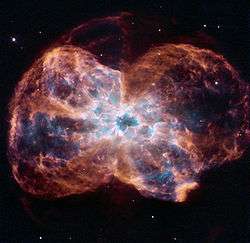
.jpg)
